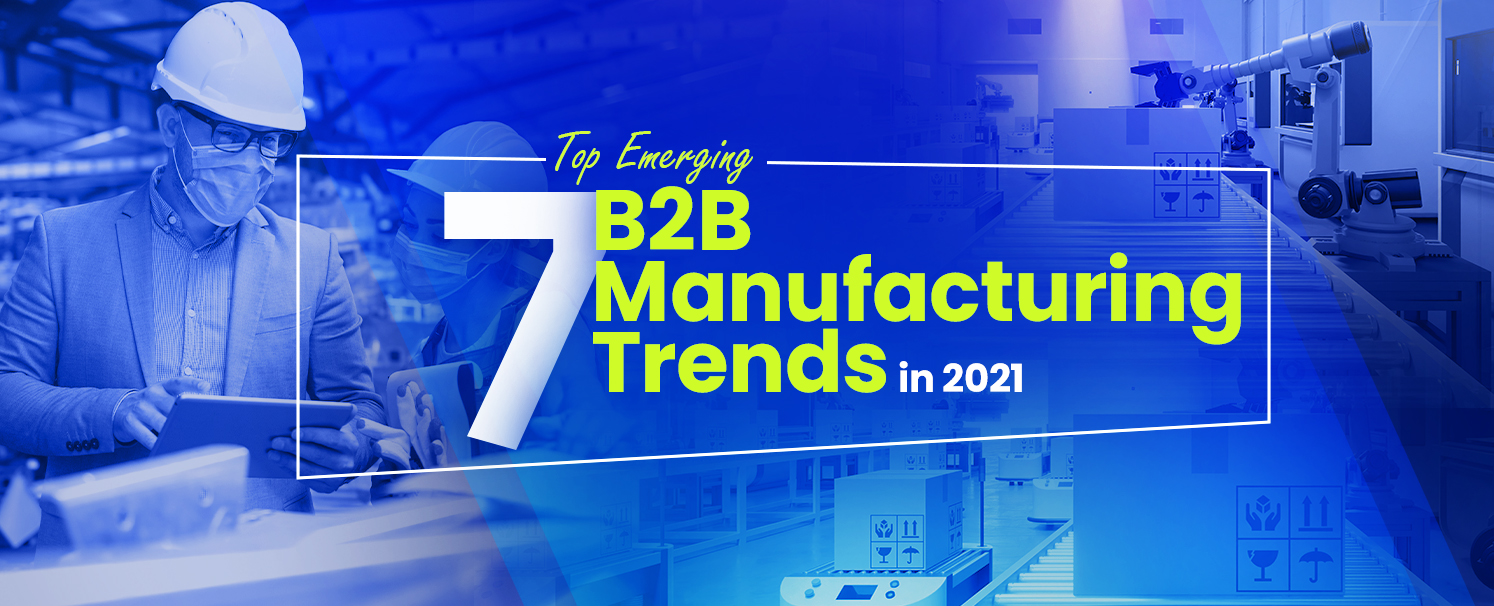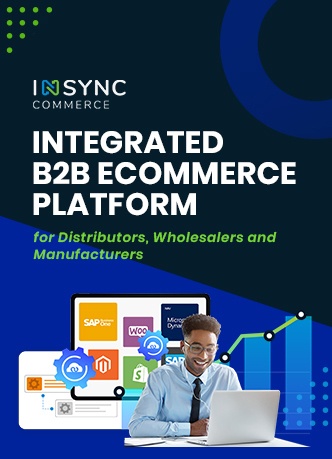
Change is the only constant. Trends that defined the B2B manufacturing industry even a few years ago have now become obsolete. With the rise of the pandemic, the global shift in industry trends has been much more drastic than the usual gradual transformation. Manufacturers are implementing advanced tools and technologies throughout their entire business process lifecycle to stay competitive in the marketplace.
With newer waves of COVID-19 on the horizon, the B2B manufacturing sector will shed off the existing industry 4.0 model and embrace the 5.0 industry revolution to adapt and grow in these changing times. Industry 5.0 won’t be just a minor advancement with some tweaks to the current industry model but a complete revolution of the manufacturing sector where the precision and efficiency of the cognitive computer will work in harmony with the creativity of the human mind to reach sustainable goals without disruptions. The dawn of the new age is already upon us, and here are the trends that will define the new era of the B2B manufacturing industry.
Top Emerging B2B Manufacturing Trends in 2021
Printed Manufacturing
While the concept of 3D printing may across as science fiction to many, 3D printing is slowly become a standard technology of the manufacturing industry. While 3D printing has been in use by manufacturers for prototyping for some time now, improvements to 3D printers and cutting edge printing polymer filaments have now enabled manufacturers to use 3D printers to produce the end product. Advancements in technology have now allowed manufacturers to print using metals such as titanium as well.
Using 3D printing for manufacturing cuts down costs and time from several processes. With traditional manufacturing, it would take companies months to develop molds and fixtures necessary for mass production. Manufacturers would depend on other companies to provide the tooling for the molds and fixtures. But with 3D printing, manufacturers can rapidly complete the tooling process on-site. Moreover, 3D printing has given manufacturers the power to bring into reality complex designs that were previously impossible with conventional machinery.
An Unbreakable Chain
A chain is as strong as its weakest link, and this goes for Supply Chains as well. The COVID pandemic has shown how fragile the existing model is. So, manufacturers are investing in technology to ensure a robust Supply Chain that can withstand the strains of changing times.
Companies are integrating new technology into every step of the manufacturing process, such as procurement, inventory, assembly, logistics, transportation, and sales. One such innovative technology is Real-Time Supply Chain Visibility. Real-time tracking of logistics has become the demand of the hour for both manufacturers and customers. These demands have led to the rise of cloud-connected sensor and tracker technology that is enabling manufacturers to scan and track inventory, vehicles, and equipment through cloud services in real-time. Manufacturers are now also focusing on implementing cutting-edge Supply Chain Visibility solutions into their operations to promotes quick response to changes. The technology will process all data points such as traffic patterns, weather, road and port conditions to redirect supply and provide the most optimized routes.
Going Big with Big Data
“Big Data” is no longer just an industry buzzword. Companies now have access to more data than ever before. Every step of the process has been transformed into a source for data collection to generate real-time insights for manufacturers.
With the ability to collect vast amounts of data from a variety of sources, combined with increasingly powerful cloud computing capabilities of AI and Machine Learning it has now become possible for manufacturers to effortlessly dissect this data in ways that provide them with a comprehensive understanding and insight of their business workflow. The insight provided by this data is essential for companies to evaluate their forecasting and planning models and develop a successful and sustainable business model. Big Data, along with AI Machine Learning, can immensely improve several aspects of the manufacturing pipeline such as:
- Inventory Management
- Supply Chain Visibility
- Cost Reduction for Warehouses
- Accurate Business Forecasting
- Cost Reduction for Transportation
Mixing Realities
With the lockdowns imposed due to the COVID-19 pandemic, having on-site technicians to assist with the installation and maintenance of equipment has become almost impossible. But with the advent of affordable Virtual Reality (VR) and Augmented Reality (AR) technology, technicians can now provide remote assistance to customers through AR and VR-enabled devices and guide them through basic troubleshooting, repair, and maintenance procedures.
Accessible VR technology has also helped improved training procedures. The manufacturing sector requires a lot of hands-on training but, training unskilled employees on live machinery can be costly and dangerous. Implementing VR technology for training purposes not only helps with increased engagement and knowledge retention but also provides a fully interactable environment for hands-on training without the associated real-life hazards. The simulation provides a safe and cost-efficient way of training employees, where they can learn without the fear of making irreversible mistakes.
Predictable Maintenance
One of the most significant costs associated with the manufacturing industry is the cost of equipment downtime. Breakdown of critical machinery is costly to manufacturers in terms of repairs, downtime, and loss of productivity. So, manufacturers must ensure that all their machinery works at optimal performance levels without malfunctions or breakdowns.
With the rise of intelligent machines, AI, and Machine Learning, manufacturers can now identify beforehand possible points of equipment failure. With predictive maintenance, companies can save on both maintenance costs and downtime while prolonging the life expectancy of their machinery. Predictive maintenance provides analytics to the manufacturers to monitor equipment performance using a range of performance metrics. The analytics and performance data offer the company the insights needed to understand how the systems work and when they will fail, enabling them to administer predictive maintenance and save time, money, and resources in the process.
Autonomous Mobile Robotics
Robots have played a major role in the manufacturing sector for ages but, most often these robots operate in isolation on a fixed assembly line or pre-determined path. But with advancements in technology, these robots can now achieve higher levels of sophistication in the form of Autonomous Mobile Robots or AMRs.
Autonomous Mobile Robot or AMR is a robot with the built-in technology to understand and navigate through its environment without a fixed pre-determined path or the help of a human operator. AMRs have an array of advanced sensors that allow them to understand, interpret and navigate their environment and helps them to perform their task most efficiently while operating around fixed obstructions and variable obstacles. AMRs are also well suited for working in collaboration with a human workforce as they can function around humans while completing non-value-adding work, like moving heavy goods, while the humans focus on skilled labor. AI and AMRs are significantly improving the precision and mobility of industrial robots while aiding in workplace safety, allowing for a new generation of collaborative robots (cobots) that can work alongside humans without the need for them to be restricted to a separate safety zone. Robots that can help pick, sort, transport, and store packages without the need for human supervision, will significantly improve and automated business processes for the manufacturing industry.
Automation for All
While Business Process Automation technology has been in the manufacturing industry for years, widespread adoption of the technology has taken place only in recent years. Process automation technology is here to stay and will only continue to improve every day with technology becoming more accessible. Automation in the manufacturing industry involves using production management software or robotic tools to operate a factory while manufacturing a physical product.
Inventory and available resources also require automated monitoring to ensure perpetual and sustainable manufacturing operation, an Enterprise Resource Planning application or ERP is required along with a robust integration platform that connects all business processes applications with the ERP. With the rise of advanced cloud-based Integration Platform as a Service (iPaaS), manufacturing companies can effortlessly implement seamless end-to-end integration of both their cloud and on-premises business process applications.
These are the top 7 trends that will define the new era of the manufacturing industry and will continue to grow and evolve into the future.
Get started with your B2B eCommerce store and gain a competitive edge in the market! Also, connect all your business applications under one single platform to automate the business process!











